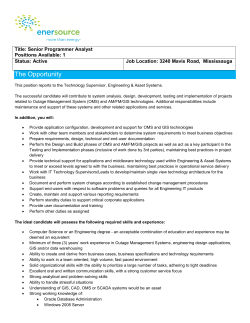
History; Software Review; Data Capture Reza Wahadj Geographic Information Systems (GIS)
Geographic Information Systems (GIS) History; Software Review; Data Capture Presented by Reza Wahadj University of California ,San Diego (UCSD) Today: 1. 2. 3. 4. 5. 6. 7. 8. 9. History of GIS and review of software Data Collection Concept of Projection Using ArcMap (in detail) Georeferencing (BIRN sample) Using ArcCatalog (create shape file, create coverage, projection) Using 3D Analyst & Spatial Analyst (create slope map, contour map) Using ArcReader (sample) Using ArcScene (sample) Tomorrow: 1. 2. 3. 4. 5. 6. Geodatabase (Personal Geodatabase , ArcSDE) Geoprocessing ArcMap, ArcINFO (Create hillshade) ArcObjects programming model and demo ArcToolbox (conversions, projections) Anatomy of ArcIMS and internet mapping ,services MetaData Explorer History of GIS Decade Milestones for computer-based GIS 1960’s - Canada Geographic Information System (CGIS) developed: national land inventory pioneered many aspects of GIS - Harvard Lab for Computer Graphics and Spatial Analysis: pioneered software for spatial data handling - US Bureau of Census developed DIME data format - ESRI founded 1970’s - CGIS fully operational (and still operational today) - First Landsat satellite launched (USA) - CARIS founded - USGS begins Geographical Information Retrieval and Analysis System (GIRAS) to manage and analyze large land resources databases and Digital Line Graph (DLG) data format - ERDAS founded - ODYSSEY GIS launched (first vector GIS) History of GIS Decade Milestones for computer-based GIS 1980’s - ESRI launches ARC/INFO (vector GIS) - GPS became operational - US Army Corp of Engineers develop GRASS (raster GIS) - MapInfo founded - First SPOT satellite launched (Europe) - IDRISI Project started (GIS program) - SPANS GIS produced - National Center for Geographic Information and Analysis (NCGIA) established in USA - TIGER digital data History of GIS Decade Milestones for computer-based GIS 1990’s - MapInfo for Windows, Intergraph, Autodesk, others - ESRI produces ArcView and ARCGIS - $7+ billion industry GIS Software • The geoprocessing engines of GIS • Major functions – Collect, store, mange, query, analyze and present • Key terms – Program – collections of instructions to manipulate data – Package – integrated collection of programs – Component – self-contained, reusable software building blocks Functionality Architecture User Interface Applications Output Analysis Translation Geographic Tools Editing Spatial Reference Display Data Manager Data Vector Access Customization Raster Product Families Autodesk ESRI Intergraph MapInfo Smallworld GeoMedia Viewer ProViewer Custom MapInfo Professional MapInfo Professional Spatial Intelligence Smallworld GIS Viewer AutoCAD LT Desktop World ArcView GeoMedia Professional AutoCAD / Map ArcEditor GeoMedia Pro Hand-held OnSite ArcPad IntelliWhere MapXtend Scout Database Server GIS Server ArcSDE Uses Oracle Spatial SpatialWare Part of Smallworld GIS Component In several products Map Objects Part of GeoMedia MapX, MapJ Part of Smallworld GIS Internet MapGuide ArcIMS MapXtreme, MapXSite CAD AutoCAD Map In several products GeoMedia Web Map, GeoMedia Web Enterprise In several products Smallworld Internet Application Server Part of Smallworld GIS ArcReader ArcInfo In several products GIS Software Classification Number of Users Internet Viewer Component Hand-held Desktop Professional Functionality Cost GIS Market Type of Software System Professional Desktop Hand-held Component Viewer Internet 0 1000000 2000000 Users 3000000 ArcSDE Unifies Spatial Data Access • ArcGIS Desktop Applications • ArcIMS , ArcExplorer, ArcPad • MapObjects ArcSDE Services SQL Server Oracle • Third-Party applications Informix IBM DB2 Enterprise GIS Organizations expect to... • Leverage existing spatial data (eliminate silos) • Integrate spatial data with core business data • Incorporate spatial into workflow between departments (for a city…tax assessor, appraisal, DPW, police, fire, IT) • Deploy IT standards to all their data • Move client / server GIS apps to the web and wireless devices • Benefit from scalability and security First, Spatially Enable The Data… Data Is Independent of Application ArcSDE ArcIMS ArcGIS SQL Server High Availability, High Performance, Secure, Scalable Publisher Authors PMF Documents ArcReader PMF ArcMap MXD Data Publisher A New Extension Distributed GIS • • Consume and expose Web services for: – Mapping – Metadata – Data sharing and distribution – Geoprocessing Provide standard services and components for web developer (.Net, “generic XML/SOAP”, or Java API’s) GIS Internet Enterprise Today Applications Browsers Web Web Server Broker Databases Future GIS Internet Enterprise Applications Browsers Web Web Server Broker Services Databases Distributed GIS Development • New Concept – g.net architecture – leveraging emerging web technologies • Web services – GIS technology for applications over the web • Mapping • Metadata • GIS Functionality – Spatial Data sharing and distribution • Extends ArcGIS System concept – Desktop Applications – Back Office Servers – Distributed “Services” via the Internet G.net Architecture Building Blocks • Network architecture (Distributed) GIS Users • Loosely Coupled • Internet Standards • Many GeoServices • Many Clients World Wide Web Metadata Server • Metadata Servers • Open / Interoperable • Full GIS capabilities Publish GIS Data & Services Document in Catalog Author, Manage, Serve Catalogs GIS GIS Portal GIS Portal Portal Author, Manage, Serve Geographic Information Collections ESRI Direction “Software for G.Net” ArcGIS ArcIMS Used to build • Serve GIS GIS Web Services • Data • Maps • Data • Maps • Models • Apps • Applications Array of GIS Clients Access and use GIS data and services • ArcReader • Map Objects for Java • Metadata ArcSDE ArcGIS Used to manage • ArcGIS Desktop & Extensions • Author and Manage Metadata • Data • ArcPad • Build Catalog ArcSDE Used to manage and distribute • Metadata Metadata & Catalog Services • Metadata • Transactions ArcIMS • Manage Metadata • Provide Search Services GIS Clients Market Forces Are Driving Change • Organizations are moving and consolidating spatial data into relational databases to improve interoperability • Organizations are moving client/server mapping applications to the web and looking to web services for the future • Organizations are integrating spatial data analysis and map visualization into key business applications to improve decision making and service delivery Data Collection • One of most expensive GIS activities • Many diverse sources • Two broad types of collection – Data capture (direct collection) – Data transfer Data Collection Techniques Raster Primary Secondary Vector Digital remote sensing images GPS measurements Digital aerial photographs Survey measurements Scanned maps Topographic surveys DEMs from maps Toponymy data sets from atlases Primary Data Capture • Capture specifically for GIS use • Raster – remote sensing – e.g. SPOT and IKONOS satellites and aerial photography – Passive and active sensors • Resolution is key consideration – Spatial – Spectral – Temporal Typical Reflectance Signatures Vector Primary Data Capture • Surveying – Locations of objects determines by angle and distance measurements from known locations – Uses expensive field equipment and crews – Most accurate method for large scale, small areas • GPS – Collection of satellites used to fix locations on Earth’s surface – Differential GPS used to improve accuracy Secondary Geographic Data Capture • Data collected for other purposes can be converted for use in GIS • Raster conversion – Scanning of maps, aerial photographs, documents, etc – Important scanning parameters are spatial and spectral (bit depth) resolution Vector Secondary Data Capture • Collection of vector objects from maps, photographs, plans, etc. • Digitizing – Manual (table) – Heads-up and vectorization • Photogrammetry – the science and technology of making measurements from photographs, etc. • COGO – Coordinate Geometry Data Transfer • Many widely distributed sources of GI • Key catalogs include – US NSDI Clearinghouse network – Geography Network • Access technologies – Translation – Direct read Federal Data Agencies • • • • • • USGS NOAA Census Bureau NIMA EPA many more...
© Copyright 2025









